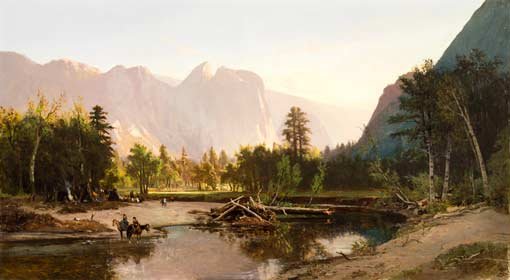The nursery of patriotism

Focus work
William Keith
Yosemite Valley 1875
Los Angeles County Museum of Art, AT Jergins Bequest, photo © Museum Associates / LACMA
In 1864, President Abraham Lincoln signed legislation granting the Yosemite Valley to California for ‘public use, resort and recreation’. This act set a precedent for the later declaration of Yellowstone as the first national park in 1872.
William Keith first journeyed to Yosemite with John Muir, naturalist and founder of the Sierra Club, in 1872. In the Yosemite Valley, Muir declared, ‘Nature had gathered her choicest treasures, to draw her lovers into close and confiding communion with her’. Keith’s painting of the placid Merced River and the massive Cathedral Rocks reflected Muir’s contrasting of the ‘stern, immovable majesty’ of rocks and the ‘frail and fleeting’ ecology of the valley floor. Keith has included in the painting both tourists and the Native American inhabitants of the valley, the Ahwahnechee, who were repeatedly evicted from the area.
Issues for discussion
Discuss the term ‘the nursery of patriotism’. What does it mean and how does this landscape painting support its ideal? What other layer of meaning has the artist captured by including both Native Americans and tourists in this scene? Is this painting a true interpretation of the landscape and the people? Discuss.
Artist biography
William Keith migrated to America at the age of 12 with his widowed mother. He began work as a wood engraver at the New York publishers Harper & Brothers in 1857 and in 1858 was sent on assignment to San Francisco, where he decided to settle. Keith studied painting with Samuel Marsden Brookes in 1863 before taking watercolour classes from Elizabeth Emerson, whom he married in 1864. Encouraged by his wife, Keith began to make watercolours of the Californian landscape. In 1868 he began oil painting, receiving a commission to paint sites along the Northwest Coast route of the Oregon Navigation & Railroad Company. Between 1870 and 1872 he travelled in Europe, spending six months in Dusseldorf, where he studied with Albert Flamm before travelling to Paris where he saw the work of the Barbizon painters. He returned to Europe twice, in 1883–85 and 1893–99. Keith travelled widely in the American West in the company of photographer Carleton E Watkins and naturalist John Muir. With Muir he explored the Sierra Madre Mountains of California numerous times, developing an intimacy with the landscape that was reflected in his light-filled, panoramic vistas of the period and earned him recognition as the chief painter of the American West Coast. In the 1880s he became influenced by the philosophy of Emanuel Swedenborg and his aesthetic moved towards atmospheric landscapes more concerned with mood and tone rather than evocations of a particular place. In the San Francisco earthquake of 1906 Keith lost more than 2000 paintings when his studio burnt down.
More information
Los Angeles County Museum of Art website